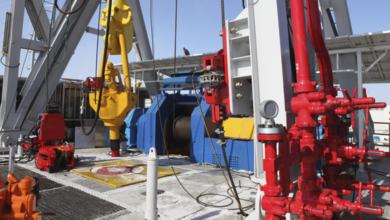D&C Tech Digest
Anadarko’s first Campos Basin pre-salt drillstem test flows 7,500 bbl/day
Anadarko reported on 6 April the results of the Wahoo 1 drillstem test in the pre-salt Wahoo field, located in the deepwater Campos Basin offshore Brazil.
The well flowed at a rate of approximately 7,500 bbl/day of 31° API gravity crude oil and 4 million cu ft/day of natural gas. The company said the flow rate was limited by equipment and facilities.
“This test confirms the world-class nature and productivity of these reservoirs, and based on data recovered, we believe this well will be capable of producing at a rate of 15,000 barrels of oil a day,” Bob Daniels, Anadarko senior vice president, worldwide exploration, said.
The company plans to move its equipment to Wahoo #2 well, 5 miles to the north, to conduct a second drillstem test. Andarko then plans to mobilize the drillship south of the original Wahoo discovery to drill the Wahoo South exploration well, which is also located on Block BM-C-30.
Kuwait Oil Co drills shallowest horizontal well in Lower Fars heavy oil project
 Kuwait Oil Company (KOC), using Rig KDC-41, has drilled what it believes to be the shallowest horizontal well ever drilled in Kuwait and the Middle East and with the shallowest kick-off point worldwide. SR-0017, the first horizontal well in the Lower Fars heavy oil project, was drilled to 2,433-ft MD at 680-ft TVD. Kick-off was at 96 ft with a max dogleg of 13°/100 ft. A lateral section of 1,290 ft was drilled through loose sand.
Kuwait Oil Company (KOC), using Rig KDC-41, has drilled what it believes to be the shallowest horizontal well ever drilled in Kuwait and the Middle East and with the shallowest kick-off point worldwide. SR-0017, the first horizontal well in the Lower Fars heavy oil project, was drilled to 2,433-ft MD at 680-ft TVD. Kick-off was at 96 ft with a max dogleg of 13°/100 ft. A lateral section of 1,290 ft was drilled through loose sand.
BP announces $600 million in 1st contracts to restart southern Iraq’s Rumaila Field
BP, on behalf of its partners in the Rumaila technical services contract, reported the first major contracts to support the rehabilitation of the Rumaila Field in southern Iraq.
The contractors were selected after a bidding process, and the awards were endorsed on 24 March in Basra by the members of the Rumaila Joint Management Committee comprising BP, China’s CNPC, the Iraqi State Oil Marketing Organization and South Oil Company.
Three contractor groups were selected to drill the wells, contracts worth around $500 million, and they will provide seven additional drilling rigs from the second half of 2010. The contracts will be awarded to Schlumberger, in partnership with Iraqi Drilling Company, Daqing Drilling and Weatherford.
Additional contracts have been awarded for the supply and installation of electrical submersible pumps and associated services to Centrilift and Al-Khorayef Petroleum. Cameron will supply the associated trees and wellheads.
Weatherford deploys 1st rotary steerable system with dry air
Weatherford International announced in early March that it has completed the world’s first runs using a rotary steerable system (RSS) to drill with dry air, in the Lower Huron formation in Kentucky. It is the longest single run with RSS technology in a dry air environment, according to the service company. The assembly consisted of a Revolution Plus RSS and an EMpulse measurement-while-drilling (MWD) system with electromagnetic telemetry. They company drilled a 6,125-ft lateral section with 4 ¾-in. tools in 46.35 hrs. The section was drilled at an average ROP of 132 ft/hr in 100% dry air.
Baker Hughes sets ROP record in Siberia, cuts costs for Khalda
Baker Hughes’ first trial of an 8½-in. PDC bit for Khalda Petroleum Company in the Tut area of Egypt’s Western Desert was successful in saving the operator $106,000, the company reported.
The company maintained an increased rate of penetration (ROP) at an average of 26 ft/hr and two offset wells at 45 ft/hr. With a rig rate of $916/hr, the average cost/ft at the offsets was $44 compared to $28 at the company’s trial. The lower cost/ft is what saved the operator money on the 6,590-ft interval.
The bit completed the section from casing shoe to casing shoe, with a total of 6,590 ft drilled, from 2,710 ft to 9,300 ft, in 145 hrs, with an average ROB of 45.4 ft/hr. The section comprised limestone, shale, sandstone and compacted siltstone formations.
In western Siberia, the company used an 8 ½-in. PDC bit on a directional well to triple a competitor’s average ROP in the same field. The 64 m/hr ROP set a field record. The record has earned the company another well in this area.
Production kicks off from Perdido, world’s deepest offshore drilling, production facility

Shell produced its first oil and natural gas from the Perdido development, the world’s deepest offshore drilling and production facility. It sits in approximately 2,450 m (8,000 ft) of water and will access reservoirs deep beneath the ocean floor.
From the first lease purchase to the 31 March production, the Perdido development required an industry workforce of approximately 12,000 people.
The facility will produce from the Great White, Silvertip and Tobago offshore fields, requiring perhaps as many as 35 wells over the life of the fields. Tobago sits in more than 2,900 m (9,600 ft) of water and surpasses the world depth record for a completed subsea well.
“This is a new frontier in many respects,” said Marvin Odum, upstream Americas director, Shell Energy Resources Company. “Perdido’s floating production facility can be expanded to serve the future potential in the area, and we can apply the technology and expertise utilized at Perdido to other similarly challenging environments in the future.”
The landmark Perdido development is the first Gulf of Mexico full-field subsea separation and pumping system, containing five caisson separators installed on the seabed. This system separates gas and liquids before the hydrocarbons are pumped back to the surface, enabling increased oil recovery by removing about 2,000 psi of back pressure from the wells.
“Gas flows up the riser while liquid is boosted by the electrical submersible pumps using multiphase separation,” said Brad Beitler, FMC Technologies’ vice president of technology.
Shell developed the gas/liquid separation technology used in the development, and FMC engineered and manufactured the caisson separators that separate gas from liquids and then pump the liquid to the spar.
WesternGeco’s UniQ seismic system helps Kuwait Oil set industry record
Kuwait Oil Company has employed the WesternGeco UniQ integrated point-receiver land seismic system to set an industry record. The system acquired data from 80,000 live digital point-receiver channels at a two-millisecond sample interval, according to the service company.
UniQ is a flexible point-receiver system that has fast-moving, low-density exploration surveys to wide-azimuth, broad bandwidth and point-source/point-receiver reservoir surveys. During sustained slip-sweep production in February, the technology acquired real-time quality of one terabyte of data/hr – the equivalent of five days of production for a typical 3,000-channel conventional crew.
All data were concurrently pre-conditioned using the Q-Xpress in-field integrated seismic data acquisition and processing workflow for near-real time seismic data analysis.
The system is being deployed in conjunction with WesternGeco DX-80 Desert Explorer vibrators and MD Sweep low-frequency technology.
Part of the Q-Technology point-receiver seismic hardware and software portfolio, the UniQ system combines extreme channel count technology with support for advanced simultaneous source techniques.
Building on the fidelity provided by the broad bandwidth geophone accelerometer sensor, the system can support up to 150,000 live channels at a two-millisecond sample interval.
“UniQ continues to set new standards of performance … proving that sustained productivity can be reliably combined with high channel count recording,” said Marwan Moufarrej, vice president, land, WesternGeco.



